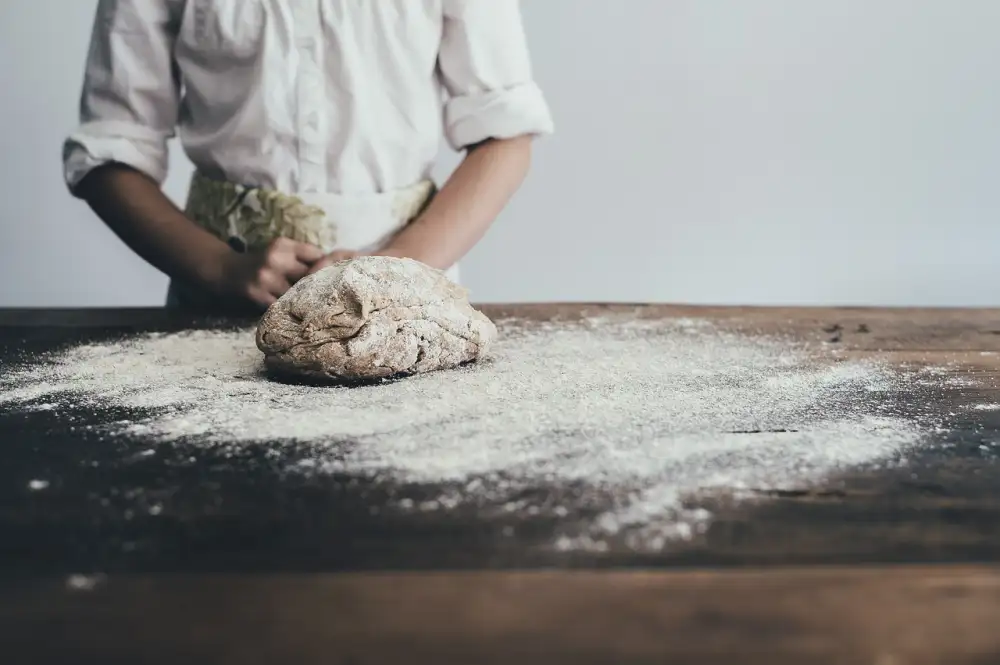Master the Art of Homemade White Bread with This Simple Recipe!

There's nothing quite like the aroma of freshly baked bread wafting through your home. And when it comes to homemade bread, white bread is a classic favorite. Whether you're a seasoned baker or just starting out on your culinary journey, mastering the art of making homemade white bread is a skill worth acquiring. With its soft and fluffy texture and versatile nature, white bread is perfect for sandwiches, toast, or simply enjoying on its own. In this article, we will guide you through a simple recipe that will help you create delicious white bread right in your own kitchen. So roll up your sleeves and get ready to embark on a baking adventure!
Ingredients needed for making White Bread
To make delicious homemade white bread, you will need the following ingredients:
1. 4 cups of all-purpose flour: This is the main ingredient for the bread dough. Make sure to use a high-quality flour for best results.
2. 2 tablespoons of sugar: Sugar adds a touch of sweetness to the bread and helps activate the yeast.
3. 2 teaspoons of salt: Salt enhances the flavor of the bread and helps regulate yeast activity.
4. 2 tablespoons of unsalted butter: Butter adds richness and moisture to the bread.
5. 2 ¼ teaspoons of active dry yeast: Yeast is responsible for leavening the dough and giving it that light, airy texture.
6. 1 ½ cups of warm water (around 110°F): Warm water helps activate the yeast and allows it to work its magic in rising the dough.
These simple ingredients are all you need to create a basic yet delicious white bread at home.
Step-by-step instructions for making White Bread
1. In a large mixing bowl, combine 2 cups of warm water (around 110°F), 2 tablespoons of sugar, and 2 tablespoons of active dry yeast. Let it sit for about 5 minutes until the mixture becomes frothy.
2. Add 1/4 cup of vegetable oil, 1 tablespoon of salt, and gradually mix in 5-6 cups of all-purpose flour until a sticky dough forms.
3. Turn the dough out onto a floured surface and knead for about 8-10 minutes until it becomes smooth and elastic.
4. Place the dough in a greased bowl, cover it with a clean towel, and let it rise in a warm place for about an hour or until it doubles in size.
5. Punch down the risen dough to release any air bubbles, then divide it into two equal portions.
6. Shape each portion into a loaf by rolling the dough tightly from one end to the other, tucking the ends underneath.
7. Place each loaf into greased bread pans, cover them again with towels, and allow them to rise for another 30-45 minutes until they reach just above the rim of the pans.
8. Preheat your oven to 375°F (190°C). Once preheated, bake the loaves for approximately 25-30 minutes or until they turn golden brown on top.
9. Remove the bread from the oven and let it cool in the pans for about 10 minutes before transferring them to wire racks to cool completely.
Follow these simple steps to achieve homemade white bread that is soft, fluffy, and delicious!
Tips and tricks for perfecting your White Bread
Tips and Tricks for Perfecting Your White Bread:
1. Use high-quality ingredients: The quality of your bread will greatly depend on the ingredients you use. Opt for fresh yeast, unbleached flour, and good quality salt.
2. Knead the dough properly: Kneading is crucial to develop gluten in the dough, which gives the bread its structure and texture. Knead for at least 10 minutes until the dough becomes smooth and elastic.
3. Allow enough time for rising: Give your dough enough time to rise properly. This allows the yeast to ferment and develop flavor. Follow the recipe's instructions for rising times, but don't rush it.
4. Control the temperature: Yeast is sensitive to temperature, so make sure your water is warm (around 110°F) but not too hot or it will kill the yeast. Also, find a warm spot for your dough to rise, like near a window or on top of a preheated oven.
5. Avoid over-flouring: While kneading or shaping your bread, resist adding excess flour as it can make your bread dense and dry. Instead, lightly flour your hands or work surface when necessary.
6. Use steam during baking: To achieve a crispy crust, create steam in your oven by placing a pan filled with boiling water on the bottom rack while baking. This helps keep the surface of the bread moist during baking.
7. Let it cool before slicing: It's tempting to slice into that freshly baked loaf immediately, but allowing it to cool completely before slicing will give you better results. This allows moisture to redistribute evenly throughout the bread.
By following these tips and tricks, you'll be well on your way to mastering homemade white bread that is fluffy, flavorful, and perfect every time!
Variations and additions to enhance the flavor of White Bread
Variations and additions can take your homemade white bread to the next level, adding depth and flavor. Here are a few ideas to enhance the taste of your bread:
1. Herbs and Spices: Add a teaspoon of dried herbs like rosemary, thyme, or oregano to the dough for an aromatic twist. You can also experiment with spices such as cinnamon or nutmeg for a sweet variation.
2. Cheese: Incorporate grated cheese into the dough for a cheesy delight. Cheddar, Parmesan, or Gruyere work exceptionally well in white bread.
3. Seeds and Nuts: Sprinkle sesame seeds, poppy seeds, or chopped nuts on top of the loaf before baking. This will add a delightful crunch and nutty flavor.
4. Garlic and Onion: Sauté minced garlic and onion in butter until fragrant, then fold them into the dough for a savory kick.
5. Whole Grains: Replace a portion of the all-purpose flour with whole wheat flour or other grains like oats or cornmeal to give your bread a heartier texture.
Remember to experiment with different combinations to find your favorite flavors. These variations will make your white bread even more delicious and unique!
Serving suggestions and storage recommendations for White Bread
Serving suggestions for White Bread:
1. Classic sandwiches: White bread is perfect for making classic sandwiches like BLTs, turkey and cheese, or grilled cheese. The soft texture and mild flavor of white bread complement a variety of fillings.
2. Toasted with butter and jam: Enjoy a slice of warm white bread toasted to perfection and spread with your favorite butter and jam combination. It's a simple yet delicious breakfast or snack option.
3. French toast: Transform your white bread into a decadent breakfast treat by using it to make French toast. Soak slices in a mixture of eggs, milk, and vanilla extract, then fry until golden brown. Serve with maple syrup and fresh fruit.
Storage recommendations for White Bread:
1. Room temperature storage: Keep your homemade white bread at room temperature in a plastic bag or bread box for up to 3 days. Make sure to seal the bag tightly to prevent it from drying out.
2. Freezing: If you have leftover white bread or want to make a larger batch for future use, wrap individual slices or the whole loaf tightly in plastic wrap and place it in an airtight container or freezer bag. Frozen white bread can last up to 3 months.
3. Thawing frozen bread: When ready to use frozen white bread, remove the desired number of slices from the freezer and let them thaw at room temperature for about 30 minutes. Alternatively, you can toast the frozen slices directly without thawing.
By following these serving suggestions and storage recommendations, you can enjoy freshly baked homemade white bread at its best for longer periods while exploring various ways to incorporate it into your meals!
In conclusion, making homemade white bread is a rewarding and satisfying experience. By following this simple recipe and using high-quality ingredients, you can create a loaf of bread that is soft, fluffy, and full of flavor.
The key to success lies in patience and attention to detail. Take the time to properly knead the dough, allow it to rise until doubled in size, and bake it until golden brown. These steps will ensure a beautiful loaf with a perfect texture.
Experiment with different variations and additions to personalize your white bread. Whether you prefer adding herbs, cheese, or even dried fruits and nuts, the possibilities are endless. Get creative and make each loaf uniquely yours.
When serving your homemade white bread, consider pairing it with soups, sandwiches, or simply enjoying it on its own with butter or jam. It also makes for delicious toast in the morning.
To keep your white bread fresh for longer, store it in an airtight container or bag at room temperature. If you have leftover slices that you won't consume within a few days, freeze them individually for future use.
Remember, practice makes perfect when it comes to baking bread. Don't be discouraged if your first attempt isn't flawless. With each batch you make, you'll gain more confidence and improve your skills.
So why not embark on this culinary adventure? Mastering the art of homemade white bread will not only fill your home with incredible aromas but also provide you with a staple that is far superior to anything store-bought. Enjoy the process and savor every bite of your delicious creation!
Published: 19. 11. 2023
Category: Food



